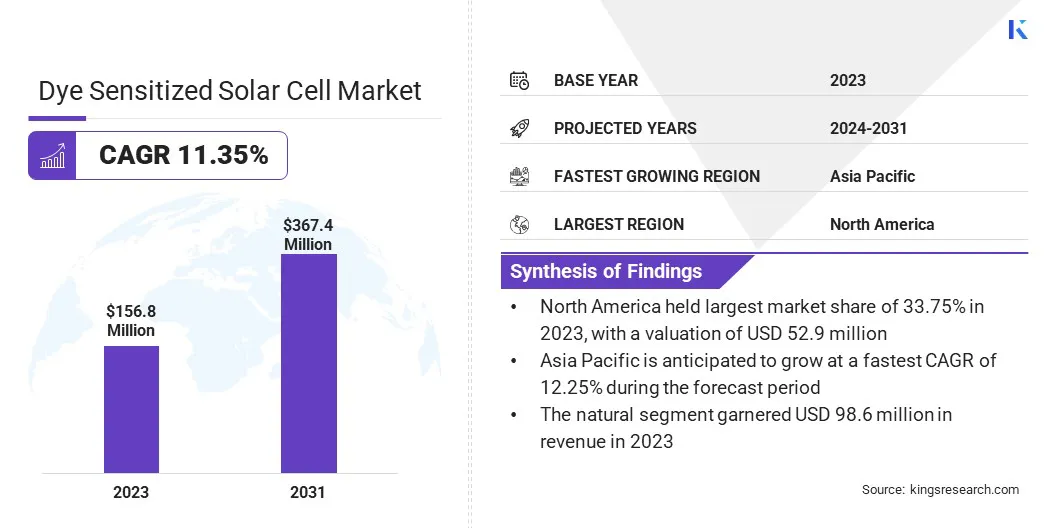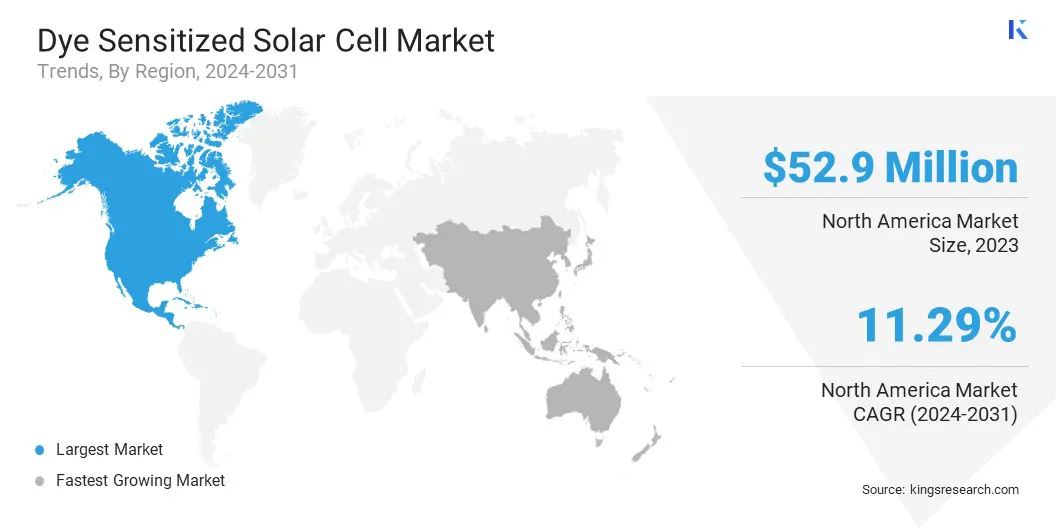Market Definition
The market encompasses photovoltaic devices that utilize dye molecules to capture sunlight and generate electricity through a photoelectrochemical process.
These cells comprise a porous titanium dioxide (TiO₂) anode coated with a photosensitive dye, an electrolyte facilitating electron transfer, and a counter electrode. DSSCs are valued for their flexibility, transparency, and ability to function in low-light conditions, which is suitable for building-integrated photovoltaics (BIPV), portable electronics, and automotive sunroofs.
Dye Sensitized Solar Cell Market Overview
The global dye sensitized solar cell market size was valued at USD 156.8 million in 2023 and is projected to grow from USD 173.1 million in 2024 to USD 367.4 million by 2031, exhibiting a CAGR of 11.35% during the forecast period.
The growing demand for flexible and lightweight photovoltaic technologies is accelerating the adoption of DSSCs in wearables, IoT devices, and building-integrated applications. Their superior performance in low-light conditions further strengthens their role in indoor energy harvesting, driving commercial adoption.
Additionally, the integration of DSSCs in energy-efficient edge AI processing is fostering market growth by enabling self-powered smart sensors and low-energy AI devices for smart infrastructure and enabling automation.
Major companies operating in the dye sensitized solar cell industry are BRITESOLAR, Exeger Operations AB, Oxford Photovoltaics Ltd., GCell, Ricoh, Solaronix SA, Greatcell Solar Materials, 3GSolar, Peccell Technologies, Sharp Corporation, Fujikura Ltd., Sony Corporation, Samsung Electronics, Ambient Photonics, and DYESOL COLOR WORKS PVT. LTD.
The increasing preference for flexible and lightweight photovoltaic technologies supports the growth of the market. DSSCs offer a significant advantage over traditional silicon-based panels due to their adaptability in diverse applications, including wearable electronics, wireless sensors, and portable energy solutions.
Their ability to conform to various surfaces makes them ideal for integration into non-conventional structures, such as curved surfaces in automobiles and consumer devices.

Key Highlights:
- The dye sensitized solar cell industry size was recorded at USD 156.8 million in 2023.
- The market is projected to grow at a CAGR of 11.35% from 2024 to 2031.
- North America held a market share of 33.75% in 2023, with a valuation of USD 52.9 million.
- The Natural segment garnered USD 230.5 million in revenue in 2023.
- The Portable Charging segment is expected to reach USD 110.0 million by 2031.
- Asia Pacific is anticipated to grow at a CAGR of 12.25% during the forecast period.
Market Driver
"Demand for Enhanced Energy Conversion in Low-Light Conditions"
Advancements in dye sensitized solar cell technology are enhancing energy conversion efficiency for low-light conditions in indoor applications. Researchers are optimizing dyes, electrolytes, and electrode materials to improve their performance under artificial lighting.
These innovations enable DSSCs to power wireless sensors, electronic shelf labels, and other low-power indoor devices. With the increasing adoption of smart home systems and IoT-connected electronics, the need for reliable, sustainable power sources is rising.
The continuous development of DSSCs for indoor energy harvesting is expanding their market potential, driving further investments in research and commercialization.
- In December 2024, researchers from India's National Institute for Interdisciplinary Science and Technology (CSIR-NIIST) reported advancements in the stability and efficiency of dye sensitized solar cells (DSSCs) for indoor photovoltaic applications. The precise structural design of dyes enables synergistic effects, optimizing molecular packing, increasing dye loading, and enhancing visible light absorption. The developed DSSC achieved an efficiency of 10.40% under standard AM 1.5 G solar radiation and demonstrated a power conversion efficiency of 40% under indoor warm white compact fluorescent lamp (CFL) illumination.
Market Challenge
"Stability and Long-Term Durability Concerns"
A significant challenge hindering the growth of the dye sensitized solar cell (DSSC) market is concerns regrading the stability and durability of the cells, particularly under prolonged exposure to environmental factors. Issues such as dye degradation, electrolyte leakage, and efficiency loss over time limit their widespread adoption.
To address this, companies are developing advanced solid-state electrolytes, UV-resistant dyes, and encapsulation techniques to enhance cell lifespan and performance.
Research into novel dye formulations and alternative redox couples is also helping improve thermal and chemical stability, ensuring DSSCs remain viable for commercial and industrial applications in diverse environmental conditions.
Market Trend
"Integration of DSSCs in Energy-Efficient Edge AI Processing"
The increasing demand for energy-efficient edge AI processing is a significant factor driving the growth of the dye sensitized solar cell market. As AI applications expand across industries, the need for low-power, self-sustaining computational devices is rising.
Energy-efficient AI solutions are crucial for real-time data processing in surveillance systems, autonomous vehicles, and wearable health monitoring devices.
Ongoing research is exploring how DSSCs can be integrated into optoelectronic synaptic devices to enable AI-driven data processing while functioning as both a power source and computational unit. These advancements are accelerating the adoption of DSSCs in next-generation smart technologies.
- A research team from the Department of Applied Electronics at Tokyo University of Science (TUS) has successfully developed a self-powered optoelectronic device based on dye sensitized solar cells, designed to mimic human synaptic behavior. This photopolymeric system features a time constant that adjusts according to the intensity of the input light, allowing for enhanced performance in time-series data processing and motion detection. By integrating optical input, AI computation, analog output, and power supply functions at the material level, this breakthrough marks a significant step forward in advancing multiple time-scale physical reservoir computing (PRC).
Dye Sensitized Solar Cell Market Report Snapshot
|
Segmentation
|
Details
|
|
By Type
|
Natural, Synthetic
|
|
By Application
|
Portable Charging, BIPV/BAPV, Embedded Electronics, AIPV, Outdoor Advertising, Others
|
|
By Region
|
North America: U.S., Canada, Mexico
|
|
Europe: France, UK, Spain, Germany, Italy, Russia, Rest of Europe
|
|
Asia-Pacific: China, Japan, India, Australia, ASEAN, South Korea, Rest of Asia-Pacific
|
|
Middle East & Africa: Turkey, U.A.E., Saudi Arabia, South Africa, Rest of Middle East & Africa
|
|
South America: Brazil, Argentina, Rest of South America
|
Market Segmentation:
- By Type (Natural and Synthetic): The natural segment earned USD 98.6 million in 2023 due to its cost-effectiveness, environmental sustainability, and ability to achieve stable light absorption, making it a preferred choice for eco-friendly and commercially viable photovoltaic applications.
- By Application (Portable Charging, BIPV/BAPV, Embedded Electronics, AIPV, Outdoor Advertising, and Others): The outdoor advertising segment is poised for significant growth at a CAGR of 11.67% over the forecast period, due to the increasing adoption of energy-efficient, self-sustaining displays and billboards that leverage DSSCs' ability to generate power in varying light conditions, reducing reliance on external electricity sources.
Dye Sensitized Solar Cell Market Regional Analysis
Based on region, the market has been classified into North America, Europe, Asia Pacific, Middle East & Africa, and Latin America.

The North America dye sensitized solar cell market share stood at around 33.75% in 2023 in the global market, with a valuation of USD 52.9 million. The increasing deployment of smart building technologies and IoT-integrated devices in North America is driving the demand for efficient indoor energy-harvesting solutions.
The region’s strong focus on energy efficiency and sustainability in commercial and residential buildings is accelerating DSSC adoption. Additionally, the rising demand for off-grid and portable energy solutions in North America, particularly for outdoor and recreational applications, is fueling the growth of DSSCs.
The U.S. and Canada, with their growing outdoor recreation industry, present a strong market for such innovations.
- The U.S. Bureau of Economic Analysis report published in November 2024 highlights that the outdoor recreation economy contributed 2.3%, i.e., USD 639.5 million to the nation’s GDP in 2023.
This substantial market presence is driving demand for portable and off-grid energy solutions, positioning DSSC-powered chargers, wearables, and backup systems as viable alternatives for outdoor and recreational applications.
Asia Pacific dye sensitized solar cell industry is poised for significant growth at a robust CAGR of 12.25% over the forecast period. Asia-Pacific is experiencing rapid development of smart cities, particularly in China, Japan, and India, driving the demand for self-sustaining energy solutions, strengthening the growth of the market.
DSSCs are also being incorporated into IoT-based urban infrastructure, including smart lighting, energy-efficient windows, and wireless sensors, to enhance energy efficiency.
A key initiative supporting this growth is the Beijing Declaration of 2024, a collaboration between China and Arab states to foster innovation, improve connectivity, and promote sustainable urban development. This strategic cooperation aligns with the broader goals of the 2030 Agenda, reinforcing the transition toward smarter, more energy-efficient cities in the region.
Furthermore, Asia-Pacific is a hub for advanced DSSC research, with institutions such as the National University of Singapore (NUS), Kyoto University, and the Chinese Academy of Sciences developing high-efficiency dye formulations and solid-state DSSC technologies. Recent breakthroughs in low-cost and lead-free DSSCs are increasing their commercial viability, attracting investment in large-scale manufacturing.
Regulatory Frameworks
- The U.S. Department of Commerce outlines regulations to oversee solar cells and modules. In August 2023, the Department announced final determinations in circumvention inquiries concerning solar products from China, highlighting the importance of compliance with trade laws.
- The EU's Renewable Energy Directive establishes binding targets for member states to increase renewable energy usage. While specific regulations for DSSCs are not detailed, photovoltaic products must comply with general EU standards for safety and performance.
- Japan encourages renewable energy adoption through various initiatives. Photovoltaic modules, including DSSCs, must comply with safety and performance standards, although specific regulations are not explicitly detailed in publicly available government sources.
- In India, the Ministry of New and Renewable Energy (MNRE) supports solar energy initiatives. DSSCs must adhere to guidelines set by the Bureau of Indian Standards (BIS) for photovoltaic systems, ensuring product quality and safety.
Competitive Landscape
The dye sensitized solar cell industry is characterized by market players that are actively investing in research and development to enhance the efficiency and durability of dye sensitized solar cells, driving technological advancements in the sector.
Companies are focusing on improving dye stability, optimizing electrolyte formulations, and developing novel photoelectrode materials to enhance power conversion efficiency. Innovations such as solid-state electrolytes and tandem DSSC architectures are expanding application scope, particularly in indoor energy harvesting and flexible solar panels.
These efforts are strengthening the commercial viability of DSSCs, fostering partnerships for large-scale manufacturing, and accelerating their adoption across various industries.
List of Key Companies in Dye Sensitized Solar Cell Market:
- BRITESOLAR
- Exeger Operations AB
- Oxford Photovoltaics Ltd.
- GCell
- Ricoh
- Solaronix SA
- Greatcell Solar Materials
- 3GSolar
- Peccell Technologies
- Sharp Corporation
- Fujikura Ltd.
- Sony Corporation
- Samsung Electronics
- Ambient Photonics
- DYESOL COLOR WORKS PVT. LTD.
Recent Developments (Partnerships)
- In January 2024, Ambient Photonics partnered with Google to develop indoor solar cell devices utilizing dye sensitized solar cell (DSSC) technology for low-light environments. These bifacial solar cells are designed to capture light from both the front and back surfaces, significantly enhancing their light-to-electricity conversion efficiency. By maximizing light exposure, this innovation can achieve nearly 2x the energy absorption compared to conventional single-sided solar cells.


